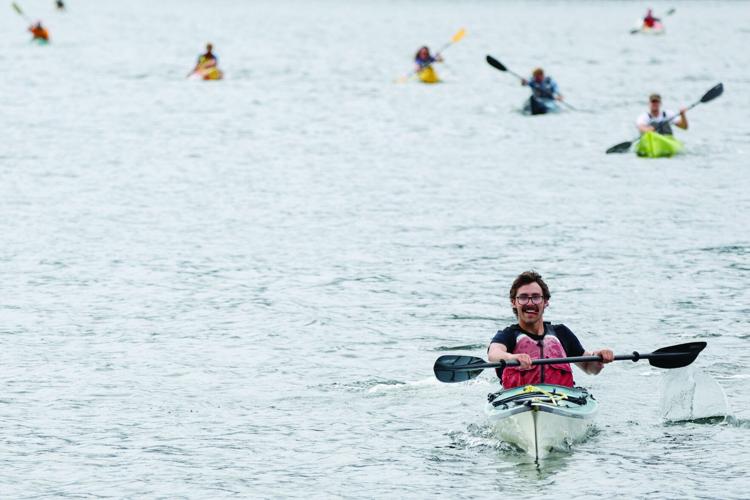Mastering the Calamity Triathlon: Alaska's Unique Kayak-Run-Bike Challenge

Introduction
Beneath the expansive Alaskan skies, a group of 16 intrepid souls and one dynamic team recently embarked on the Calamity Triathlon in Ketchikan—a multisport event that swaps the traditional swim for a kayak adventure through the stunning coastal waters. This event is not just a race; it's a celebration of Alaska's rugged beauty, challenging the norms of triathlon with a kayak-bike-run format.
This year, we saw remarkable efforts from all participants, with Gavin Groshelle clinching the overall victory and 14-year-old Josephine Jackson impressing as the first female soloist to finish. The course took competitors around Devil Island and through some of Alaska’s most breathtaking landscapes, making the Calamity Triathlon a magnet for those seeking adventure and a test of their athletic prowess.
The Unique Calamity Format
Distinct from the standard swim-bike-run, the Calamity Triathlon offers a refreshing twist by showcasing Alaska's natural splendor:
Stage 1: Kayaking (2 miles)
The adventure begins at Totem Bight State Historical Park, where athletes embark on a two-mile kayak journey. This segment challenges participants with its demands on upper body strength and navigational skills, setting the tone for the competition.
Jared Gross led this segment, completing it in a swift 23:02, though times varied significantly across the board, demonstrating the challenging nature of this discipline.
Stage 2: Running (5 kilometers)
Transitioning from water to land, competitors next tackle a 5-kilometer run. This segment tests their ability to shift gears and adapt to different muscle demands, a stark contrast to the usual swim-to-bike transition in traditional triathlons.
Gavin Groshelle shone here as well, posting the fastest run split at 21:25, which was instrumental in securing his overall victory.
Stage 3: Cycling (8 miles)
The final leg is an eight-mile bike ride, where athletes push their limits against the backdrop of Alaska’s scenic coast. This segment not only tests endurance but also the ability to stay focused through fatigue.
Bennett Morgenstern of the "Salmon Run" team showcased his fresh legs with the fastest bike time of 29:30, highlighting the strategic advantage of team participation.
Race Highlights and Notable Performances
Individual Champions
Gavin Groshelle dominated with a total time of 1:18:55, showcasing his balanced skill set across all three disciplines.
Josephine Jackson broke through as the first female soloist, finishing in 1:38:47. Her performance is a beacon of inspiration, especially for young athletes.
Segment Specialists
- Kayak Specialist: Jared Gross, with the fastest kayak time.
- Running Powerhouse: Gavin Groshelle, whose running split was unmatched.
- Cycling Expert: Bennett Morgenstern, who excelled in the cycling leg.
Team Competition
The "Salmon Run" team triumphed with a collective time of 1:26:27, demonstrating the power of specialization and teamwork in such diverse challenges.
Preparing for a Kayak-Based Triathlon
Key Differences in Training
Training for a kayak-based triathlon involves unique considerations, from mastering kayak handling and building core rotational strength to transitioning effectively between different types of physical activity.
Equipment Essentials
Kayak Segment:
- Choose the right kayak and paddle
- Ensure safety with a proper PFD and appropriate attire
Running and Cycling Segments:
- Invest in trail-appropriate running gear and a reliable bike
- Prepare for all weather conditions, typical of the Alaskan coast
Transition Strategy
Effective transitions are crucial in the Calamity Triathlon. Practice combining kayaking with running in your training to enhance your adaptability and performance on race day.
The Community Aspect of Calamity Triathlon
The Calamity Triathlon is more than a race; it's a testament to Ketchikan’s community spirit and the allure of Alaska’s natural landscapes. It fosters a sense of unity and showcases the local commitment to outdoor activities and environmental appreciation.
Looking Ahead: Participating in Future Calamity Triathlons
For those drawn to this unique challenge, start your preparation early. Familiarize yourself with each discipline, particularly kayaking if it's new to you, and build a training regimen that reflects the diverse demands of this triathlon.
Conclusion
The Calamity Triathlon is an exceptional event that offers more than just a physical challenge—it’s a journey through some of the most picturesque terrains in Alaska and a celebration of the human spirit’s capacity to adapt and overcome. Whether you’re a seasoned athlete or a newcomer, this event promises a rewarding experience that goes beyond the finish line.
Who won the Calamity Triathlon in 2025?
Gavin Groshelle won the Calamity Triathlon in 2025 with a time of 1:18:55.
Who was the first female soloist in the 2025 Calamity Triathlon?
Josephine Jackson, 14, was the first female soloist with a time of 1:38:47.
What does the course of the Calamity Triathlon include?
The course includes a two-mile kayak leg from Totem Bight State Historical Park, a five-kilometer running leg from Refuge Cove to D-Loop and back, and an eight-mile bike leg from Totem Bight to Settlers Cove State Recreation Site.
Who recorded the fastest kayak leg time in the 2025 Calamity Triathlon?
Jared Gross recorded the fastest kayak leg time with 23:02.
Who were the sponsors of the 2025 Calamity Triathlon?
The event was co-sponsored by Ketchikan Parks and Recreation, Alaska State Parks, and the Ketchikan Area State Parks Education and Recreation.
Source: https://www.ketchikandailynews.com/news/sports/groshelle-takes-first-in-calamity-triathlon/article_4a2f0bac-64fc-4fff-867c-7227ba5173a2.html
Discover unique triathlon-themed merchandise, including stylish t-shirts, stickers, phone cases, and home decor - perfect for endurance sports enthusiasts and athletes. Shop now






